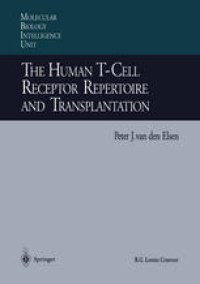
Ebook: The Human T-Cell Receptor Repertoire and Transplantation
- Tags: Immunology
- Series: Molecular Biology Intelligence Unit
- Year: 1995
- Publisher: Springer-Verlag Berlin Heidelberg
- Edition: 1
- Language: English
- pdf
these analyses it became clear that the MHC class I molecule com prised a distinct groove on the external side of the molecule. The sides of the groove are formed by the a-helical structures of the a and a 1 2 domains and a floor which is formed by 8 anti-parallel 13 strands. The various polymorphic residues, as determined from DNA sequence analysis, are localized within these a-helices and 13-plated sheets within the groove. More importantly, these analyses also revealed the presence of elec tron-dense material in the groove. This material was subsequently iden 568 10 tified as a linear peptide of 8-10 amino acids long. • •- High resolu tion crystallographic analyses of the class I MHC structure have revealed the existence of so-called pockets within the grooves of the MHC class I molecules. These pockets designated A-F, exhibited allele-specificity and are directly involved in the binding of the peptide, primarily through interaction with the dominant anchor residues as found in MHC class I associated pep tides. 6,7,9,11 The class II MHC antigens consist on the cell surface of a 34 kD a chain non-covalently associated with a 28 kD 13 chain. With the excep tion of the DR a-chain, all other MHC class II a and 13 chains are poly morphic.
This book is about T cell receptor V gene segment usage among graft-infiltrating T-lymphocytes. The current understanding of the composition of the circulating peripheral T cell receptor repertoire and the structural features of T cell receptors employed by (allo)antigen specific T-lymphocytes and among graft-infiltrating T-lymphocytes are discussed.